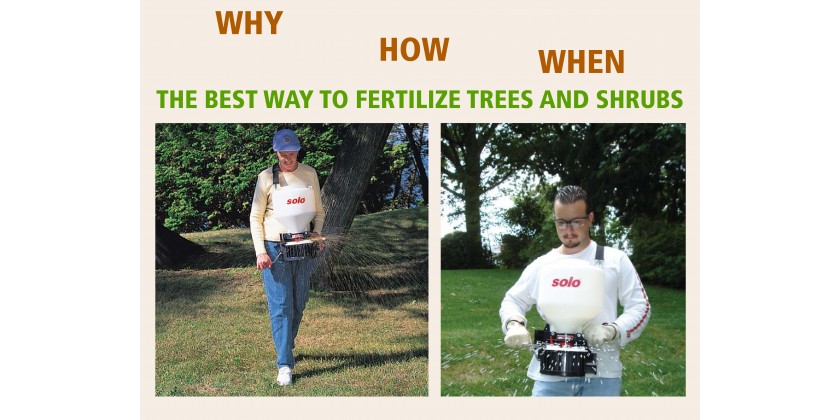
Do trees and shrubs in your yard need to be fertilized? What kind of fertilization is best for trees and shrubs? What happens if trees aren’t fertilized? When is the best time of the year to apply fertilizer to trees? How should you do it? Keep reading for answers to those questions about fertilizing trees and shrubs and many more.
DO TREES AND SHRUBS IN YOUR YARD NEED TO BE FERTILIZED?
If you have trees and shrubs, chances are you need to fertilize them. Trees and shrubs that grow in forests and woodlands get their nutrients from the soil they grow in, but the soil in urban and suburban areas is not native soil as soil is compacted and depleted of nutrients. Tree roots struggle to grow in compacted soil because they can’t penetrate the heavy material. Water either runs off compacted soil or collects and doesn’t drain. When developers build urban and suburban areas, they may use the subsoil from excavation as landscape soil. Unlike topsoil, this subsoil has few to no nutrients in it and can’t support healthy tree and plant growth. In undisturbed forests, fallen leaves, twigs, and fruit collect on the ground. All this nutrient-rich organic matter breaks down into the soil for tree roots to use. Sadly, in urban areas, this is all raked up and thrown away.
WHAT’S THE DIFFERENCE BETWEEN SYNTHETIC AND ORGANIC FERTILIZERS?
Many fertilizers are called “synthetic” because they’re created or synthesized from inorganic, chemical sources. This is different from an “organic” soil fertilizer made from organic matter, meaning things that were once alive (for example, leaves, wood, animal manure). Synthetic fertilizers generally work more quickly than organic but have the shorter-term benefits for soil or plant health.
WHICH TYPE OF SYNTHETIC FERTILIZER SHOULD I USE FOR TREES AND SHRUBS?
To provide the best and lasting support to your trees and shrubs use a slow release fertilizer, which will slowly dissolve and feed the plants at a nice steady controlled rate. If you are not sure about what kind of fertilizer your trees need, don’t guess. You could be doing more harm than you think. Both the wrong kind of fertilizer and the wrong amount will have negative effects. Different types of trees and shrubs have different needs. If you want more fruit, for example, you don’t give your fruit tree lots of nitrogen, as nitrogen stimulates green leaf growth, not fruit growth. Likewise, potassium fertilizer won’t help yellowing leaves as it encourages fruit development.
HOW CAN I TELL IF MY TREES AND SHRUBS NEED TO BE FERTILIZED?
When your trees are lacking the nutrients they need, they struggle to grow. You’ll see several symptoms, including:
- Stunted growth
- Thin or patchy foliage
- Yellow leaves
- Dropped leaves
- Insects and diseases
WHAT HAPPENS TO TREES AND SHRUBS THAT AREN’T FERTILIZED?
Your trees and shrubs will keep trying to grow even when they are lacking vital nutrients, but their long-term health won’t be good. The combination of stunted growth and chronic nutrient stress during growing seasons will shorten its lifespan significantly. Many homeowners compound the problem by mistaking the signs of nutrient deficiency for water stress and overwatering the trees, or they over-prune thinking this will stimulate more growth.
SHOULD I FERTILIZE A NEWLY PLANTED TREE OR A SHRUB?
A young tree comes with a small store of food energy that it needs to conserve, and a small rootball that must supply all the nutrients the tree needs. Your new tree may need some extra fertilizer to help until it can grow more leaves and more roots. Be sure that you don’t over fertilize your new tree! Planting or transplanting is stressful for a tree, and it needs some time to recover. Too much fertilizer will stimulate more growth than a young tree can support.
WHAT IS THE BEST WAY TO APPLY FERTILIZER?
You can put on gloves and spread the fertilizer by hand or use a scoop and sprinkle the fertilizer around the plants to cover the entire root zone area on a small property. The root zone area extends a few feet beyond the drip line, an imaginary ring on the ground directly below the outer circumference of the tree’s branches. On a larger property, a spreader is an excellent tool for spreading fertilizer because of its ability to spread evenly. There are a variety of spreaders you can use to spread the fertilizer. When choosing a spreader, consider the size and terrain of your property. Chest-mount spreaders are ideal for irregular terrain or middle to large yards.
IS IT POSSIBLE TO USE TOO MUCH FERTILIZER?
Over fertilization is a serious problem. If you’re a homeowner buying packaged fertilizer, follow the instructions on the label. More is not better! When you give your tree too much fertilizer, you’ll see several symptoms, including:
- Brown leaf edges or leaf tips
- Yellow, limp leaves
- Leaf drop
These symptoms can look just like signs of nutrient deficiency.
WHEN SHOULD I FERTILIZE MY TREES AND SHRUBS?
Spring is the best times for tree and shrub fertilization after the last frost. A good rule of thumb is when daytime temperatures are consistently in the 70s which means soil temperatures are in the 60s. If you fertilize too early, the plant will focus on shoot growth, and you will sacrifice root growth. Deep roots help your plants to better withstand drought conditions during summer months. Spring fertilizing helps ensure your trees and shrubs have enough nutrients for maximum leaf and flower growth. This means you’ll have vigorous trees and shrubs that will give you summer shade and healthy crops of fruit.
